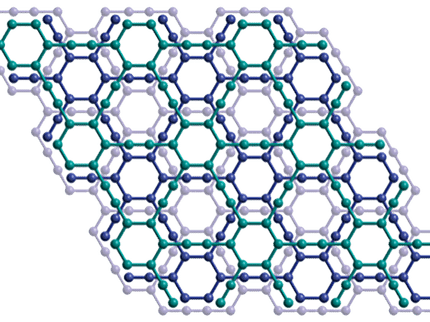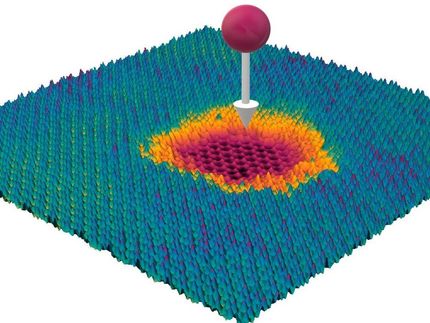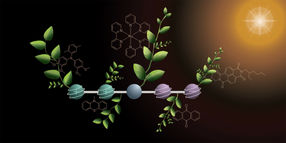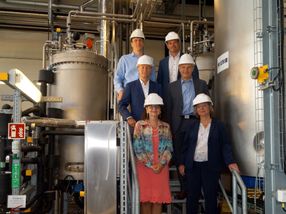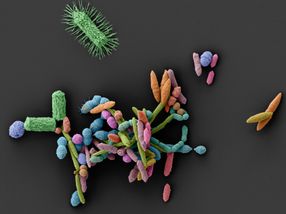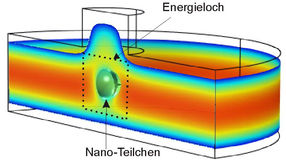Spin-off "AERO MATERIALS" launches with nanomaterials
Kiel University start-up launches a material on the market that consists almost entirely of air and can be controlled electrically
Advertisement
With a material that consists of more than 99.9 percent air, the new start-up "AERO MATERIALS" aims to optimize technical motion sequences and air pressure systems. The extremely lightweight material was developed over a decade at Kiel University (CAU) in Professor Rainer Adelung's working group. Now the team is bringing the nanostructure from the laboratory to the market. AERO materials GmbH has been operating as an independent company since September 2025.

Scanning electron image: Initial structure of the material - tiny zinc oxide tetrapods coated with a nanometer-thin layer of graphene.
© Funktionale Nanomaterialien, Dr. Florian Rasch
"Our aeromaterials are so light that you can hardly feel them in your hand," says Rainer Adelung, Professor of Materials Science at Kiel University. "At the same time, they are so functional that they can replace entire systems. This is a real game changer for many applications."
The new material opens up four key areas of application: Actuation, in which movements can be triggered quickly, precisely and energy-efficiently; filtration, in which the conductive, open-pored structures open up self-cleaning filters; optics, in which the material directs and scatters light in a targeted manner, thus enabling particularly energy-saving lighting solutions; and electromagnetic shielding of sensitive electronics - for example in drones or other mobile devices, where every gram counts.
A framework made almost entirely of air
Aeromaterials are based on tetrapodal zinc oxide (t-ZnO) structures - tiny particles that look like four-armed stars. The researchers shape this basic structure into a three-dimensional scaffold and impregnate it with a mixture of water and graphene - a single layer of carbon atoms - or with silicate, the basic material for glass. They then chemically remove the zinc oxide. What remains are hollow tubes with ultra-thin walls in the nano range. They form an open network of pure graphene sheets or glass structures with an extremely low density, which means that it consists almost entirely of air. The open porosity is retained so that air and liquids can continue to flow through unhindered.
Triggering movements quickly, precisely and energy-efficiently
The first market the team wants to tap into is actuator technology - for example, components that convert electrical signals into movement. The innovative nanomaterial is to be used in micropneumatics in particular, where the smallest air flows are used to precisely move machine components: Graphene is extremely light, conductive and stable. If electricity flows through the structure, it heats up within milliseconds. The enclosed air expands and releases a mechanical force - for example for cutting, moving or switching in automated systems. A material weighing just a few milligrams can lift up to 2 kilograms.
Unlike conventional pneumatic systems, the technology does not require an external compressor. Movement is created directly with the material, without hoses, valves or complex infrastructure. "This reduces maintenance costs and allows for particularly compact, flexible designs - for robotic applications, for example," says Caprice Mohr, Technical Managing Director and Master's student in Rainer Adelung's group. For the developers, this is an energy-efficient and sustainable alternative to conventional solutions.
Initial tests were successful
In cooperation with industrial partners, the team also tested the use of the material in other areas, for example as a loudspeaker membrane. The structure is electrically activated and begins to vibrate - similar to conventional membranes, but with significantly less mass. This allows it to cover the entire audible frequency range while reacting particularly quickly and precisely.
The material also offers advantages in the area of filtration: dust and dirt particles that accumulate in the conductive structure can simply be burned out. A prototype for self-cleaning filters has already been successfully tested in an aircraft.
Spin-off from the "Functional Nanomaterials" research group
Several patents were granted between 2015 and 2025, which are held by the CAU. With capital resources for the first few years, the team is now focusing on the first pilot customers and the path to series production. The spin-off was accompanied by the Technology Transfer department, which provided support with property rights, among other things.
Behind AERO MATERIALS are Caprice Mohr, currently a Master's student at the CAU and Technical Managing Director of the start-up, and Niklas Dreiskämper as Commercial Managing Director. Colleagues from Rainer Adelung's research group also work in the technical team. The spin-off was made possible thanks to the commitment of a group of investors, including Kai Kruse and Dr. Jörg Haupt. The start-up is located in the immediate vicinity of the Faculty of Engineering and uses the university's research infrastructure. Rainer Adelung supports the company on the advisory board.
Note: This article has been translated using a computer system without human intervention. LUMITOS offers these automatic translations to present a wider range of current news. Since this article has been translated with automatic translation, it is possible that it contains errors in vocabulary, syntax or grammar. The original article in German can be found here.
Other news from the department business & finance
Most read news
More news from our other portals
Something is happening in the chemical industry ...
This is what true pioneering spirit looks like: Plenty of innovative start-ups are bringing fresh ideas, lifeblood and entrepreneurial spirit to change tomorrow's world for the better. Immerse yourself in the world of these young companies and take the opportunity to get in touch with the founders.




